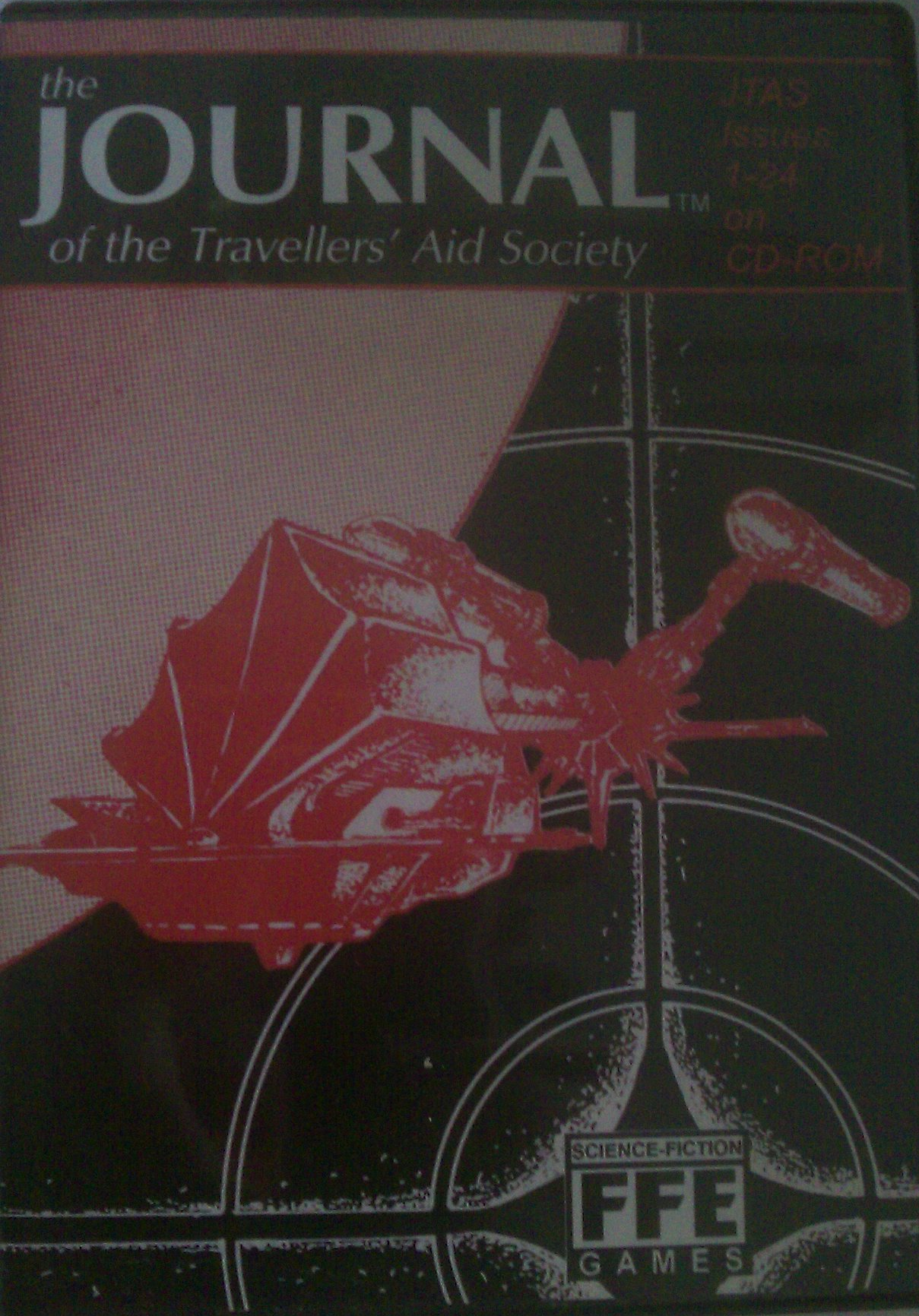CD-ROM: The Journal of the Travellers’ Aid Society
Editor’s Note: This article originally appeared in Freelance Traveller’s May 2011 issue.
 The
Journal of the Travellers’ Aid Society on CD-ROM. compiled by Marc
Miller
The
Journal of the Travellers’ Aid Society on CD-ROM. compiled by Marc
Miller
FarFuture Enterprises http://www.farfuture.net
US$35.00
I recently purchased four of the compilation CDs from Marc Miller’s Far Future Enterprises (FFE) site. At the time I made the purchase, there was a buy-3-get-1-free sale in effect, and as I did not have all of the material I decided to take the plunge. When the Journal of the Travellers’ Aid Society (JTAS) was first published I only had the original 3 Black Books. And those were enough to play with. Now, with far more disposable income at my disposable I thought I would take the plunge and investigate the beginning of the JTAS.
Packaging
The JTAS CD-ROM comes in a regular black full-sized DVD case. The outside has a nicely printed label, with the back cover having a collection of all the various covers for the different magazines. The CD itself has been printed upon it, not a cheap label. Overall the production quality of the packaging is high.
Contents
Just like the label says, you get the first 24 issues of the JTAS, plus the next 12 that were folded into the Challenge magazine. It's the typical old-school Traveller set of material—a copy of each magazine was taken apart, scanned, and then converted into a file. Everything is there—including the ads! It’s an interesting nostalgia trip for those that remember Traveller from the early days (not to mention some of the now-defunct gaming companies like Martian Metals and the Compleat Strategist - at least I think they are defunct).
[Editor’s note: The Compleat Strategist is still around, at the same location in NYC that it was back in the 1970s and 1980s. Your Editor uses it as his source for new Traveller material.]
Accessing the Files
Placing the CD inside the drive activates the menu system (it’s active content, so your computer should pop up a warning about the danger of running active content). Clicking past the warning you’ll get to the main menu. It’s simple, but efficient. First it lists the original 24 issues, with each issue getting its own hyperlink
[Editor’s note: the autorun in question is for Windows-based systems only; it will not behave this way on Mac or Linux systems. On those systems, simply use any web browser to open up index.html on the CD’s root directory, or browse the PDFs directly.]
The Content
Each issue is numbered and labeled with the primary article that was the centerpiece of that issue. Browsing through the files I discovered some interesting articles that are still relevant to all versions of Traveller (like jump points in a system that are naturally going to be clear of objects (LaGrange-points in some instances) and what type of encounters you may have around them - certainly still useful today.
Other articles are included (and later were expanded upon and received their own little black book) like Broadsword-class cruisers, Darrians, the Aslans, etc. It’s interesting to read the first ideas on these sorts of things and then later compare it to the expanded source book. And, of course, we should not forget the ever useful and interesting Traveller News service articles.
Moving on to the Challenge articles - I’m a bit more disappointed here. When Challenge magazine came about, JTAS got folded into it. Which made sense from an economic standpoint, however Traveller certainly got the short end of the stick here. The amount of material in each of the first 12 Challenge/JTAS articles pales in comparison to the original JTAS. Challenge covered all of GDW’s games (or at least their most popular ones), and each issue had to share space with the other games in their display of source material. I think the Traveller universe definitely was sacrificed for the greater good.
Production Values
Overall I would grade the effort as good, but it could stand some improvement. The files are produced by scanning collating the scans into a single pdf file. The scan resolution isn’t too high, but it’s adequate for text and the blocky illustrations of the day. Some of the scans are slightly tilted or angled, indicating that it was probably scanned on a home scanner.
It’s virtually all black and white text, with some color (like the covers, and a few ads). It's all very usable and playable. Just short. Which, I suppose, was how it used to be in the original magazines, so I can’t fault them for that.
Conclusion
Overall I would say that I was pleased with my investment. It’s clear that more than a token effort was given to make the compilation. Production quality could stand a slight increase, but for such a niche market, I’m not sure the rate of return would have justified it. I will probably subscribe to the newest version of the magazine to check out the archives. A game master can never have too much good adventure material lying around!
 Freelance
Traveller
Freelance
Traveller